A Sunshine Double: Recapping MLRC Conferences in Los Angeles and Miami
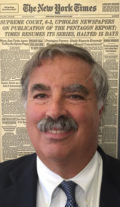
In tennis, the back-to-back Spring tournaments for both men and women, first in Indian Wells (hard by Palm Springs) and then Miami, are called the Sunshine Double. Late last month, we had our version of the Sunshine Double, in the media law conference space, with two conferences just four days apart in Los Angeles and then Miami. The former was our 20th annual Entertainment Law Conference which drew about 135 attendees; the latter was our Latin American Media Law Conference attended by a smaller but cozier crew, coming from both South America and Florida. Unlike the tennis Sunshine Double where Carlos Alcaraz and Elena Rybakina won at Indian Wells and got to the semi-finals and finals (respectively) at Miami, at our conferences everyone present was a winner, as both conferences presented engaging and information-packed programs and great and fun opportunities to mix and mingle with colleagues interested in those particular areas. (BTW, IMO Alcaraz will win more majors than the current Big Three before he’s done.) And unlike the tennis Sunshine Double, where pretty much the same top players compete in both tournaments, Diana Palacios of DWT, who moderated sessions at both conferences, and I were the only double attendees.
I should add that one other difference was the weather. We moved our Entertainment Law Conference from January to March this year for a number of reasons, one of which was to guarantee us a warmer and drier clime. That didn’t work out too well as it was cold and rainy every day Jeff Hermes and I were in LA, far from typical or expected SoCal weather. In Miami it was sunny and very hot, but jammed: in addition to an electronic rock concert for thousands in a downtown park and the aforementioned tennis tournament, it was the last week of Spring Break – there were some shootings in the days right before Dave Heller and I got to Miami, some streets near the ocean were blocked and, in general, the city seemed overrun. But that in no way inhibited the hearty MLRC conference goers who navigated the traffic and crowds skillfully and cheerfully.
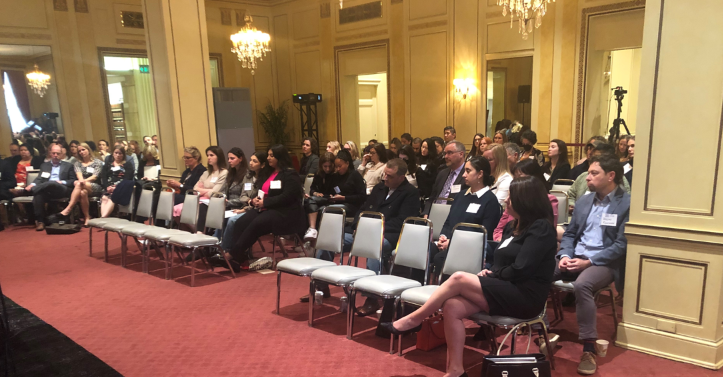
The 20th annual Entertainment & Media Law Conference was held on Thursday afternoon March 23. We were thrilled to return on this special anniversary to the lovely space at Southwestern Law School where we last held the conference before the pandemic, and to partner once again with the team at Southwestern’s Biederman Entertainment & Media Law Institute.
The Supreme Court celebrated our anniversary by hearing argument in two major intellectual property cases this term, providing plenty of material for our first two sessions. In the first session, “Warhol Foundation v. Goldsmith and the Future of Fair Use,” our panel analyzed the Court’s struggles with the concept of transformative use in copyright, and how it relates to the other fair use factors, the derivative use right, and the idea/expression dichotomy. The panel gave particular attention to how the Court’s upcoming decision might affect sequels, spinoffs, and other content that relies upon existing material to tell new stories. Moderated by the MLRC’s Jeff Hermes, the panel featured the Warhol Foundation’s counsel, Andrew Gass (Latham & Watkins), alongside Aaron Moss (Greenberg Glusker), Eleanor Lackman (Mitchell Silberberg & Knupp) and Dale Cohen (UCLA).
I found most intriguing that the district court hinged its fair use finding on its analysis that the original photograph showed Prince in a very human way, somewhat depressed, while the later Warhol print portrayed him as a celebrity. Though I come out on the fair use side – after all, a colorful and unique Warhol-styled painting adds quite a bit to the staid photo, I am very dubious anyone other than the trial judge would describe or characterize the two works in the fashion he did. Though most observers think SCOTUS will side with Lynn Goldsmith, the photographer, our panel seemed to think the case would be thrown back to the district court, though there was no real consensus as to what the Court’s instructions might be. I couldn’t help but take a probably too elemental view of the case: I very much doubt Ms. Goldsmith would not have taken the photos of Prince had she known that Andy Warhol would many years later somehow use her photo as a baseline for a painting — and isn’t that the basic purpose of copyright law, to encourage creation and authorship and not keep new works from being created.
Our second session, “Protecting Creativity with a Bottle of Jack on the Floribama Shore,” was extremely timely, discussing the Jack Daniel’s Properties v. VIP Products case the day after it was argued before the Supreme Court. The panel discussed the ongoing importance of the Rogers v. Grimaldi test for the use of trademarks in the titles of creative works and reviewed the recent Court of Appeals decision in MFGB Properties v. Viacom (the “Floribama Shore” case), before diving into the Jack Daniel’s oral argument. That led to a lively discussion of whether commercial products (such as the three dog toys that were passed around the audience) can have expressive elements that should receive special protection, whether the dog toys were a parody and whether that wholly protected them if they were, and how the case could affect the use of trademarks as titles and in other creative contexts. Kevin Vick (Jassy Vick Carolan) led the panel, which included Evynne Grover (QBE Insurance), Lynn Jordan (Kelly IP), Giulio Yaquinto (Pirkey Barber), Susan Kohlmann (Jenner & Block) and Prof. Rebecca Tushnet (Harvard Law School) – the latter two who attended the oral argument in DC the day before and flew cross-country to discuss it with us. There was no consensus on how the Court would rule, but it’s a great case for a conference or a law school – humor and a parody with no possibility of any consumer confusion on one side and a clear exploitation of a famous brand on the other.
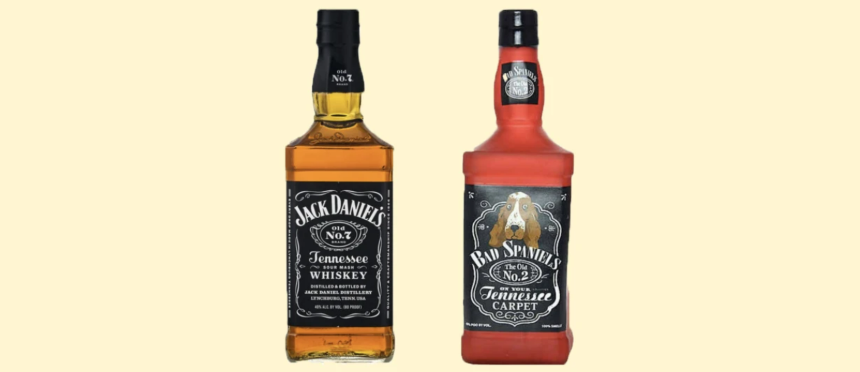
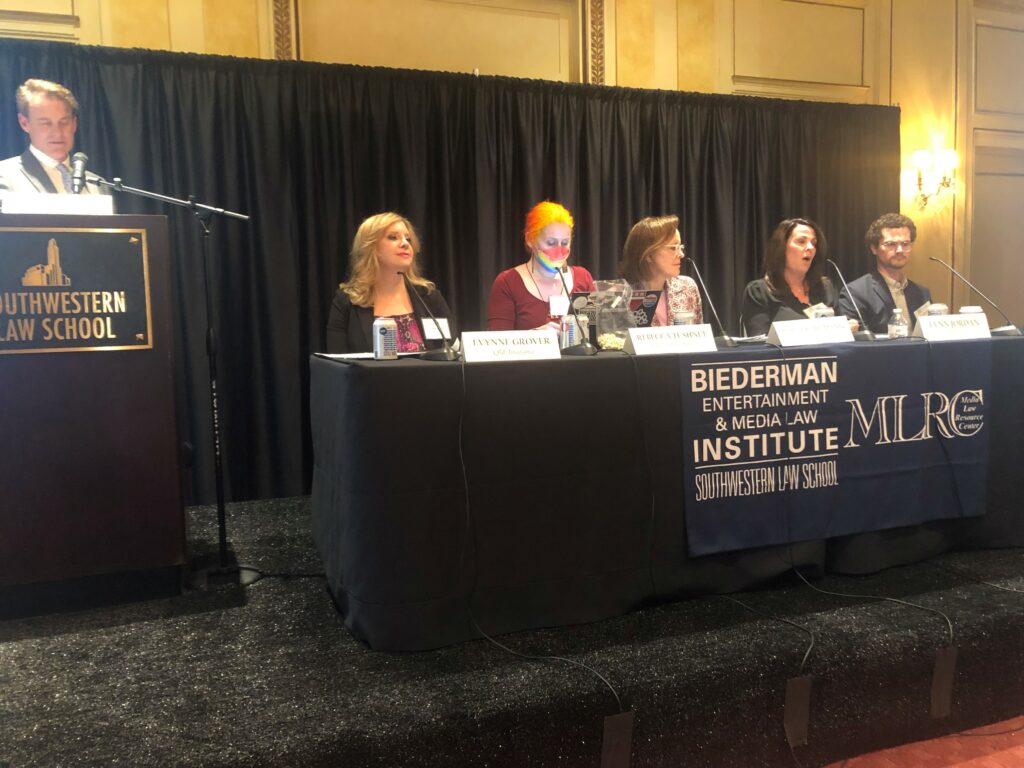
We changed gears for our third session, “Danger and Intimacy on Set: Safeguards and Lawsuits,” which focused on evolving standards for protecting those on film sets against physical and psychological harm and the legal risks faced by studios. The panel discussed the litigation and criminal prosecutions arising out of the Alec Baldwin shooting on the set of Rust, standards for consent by actors asked to participate in simulated sexual activity, the changing expectations around COVID-19 precautions, and more. Of particular interest was the role of an Intimacy Coordinator on a film set and how their participation could ameliorate the unequal power levels of directors and their actors, as well as potential legal risks. The session was moderated by Orly Ravid (Southwestern Law School), and featured Rachel Fiset (Zweiback, Fiset & Zalduendo), Danielle Van Lier (SAG-AFTRA), and Claire Warden (Intimacy Directors & Coordinators).
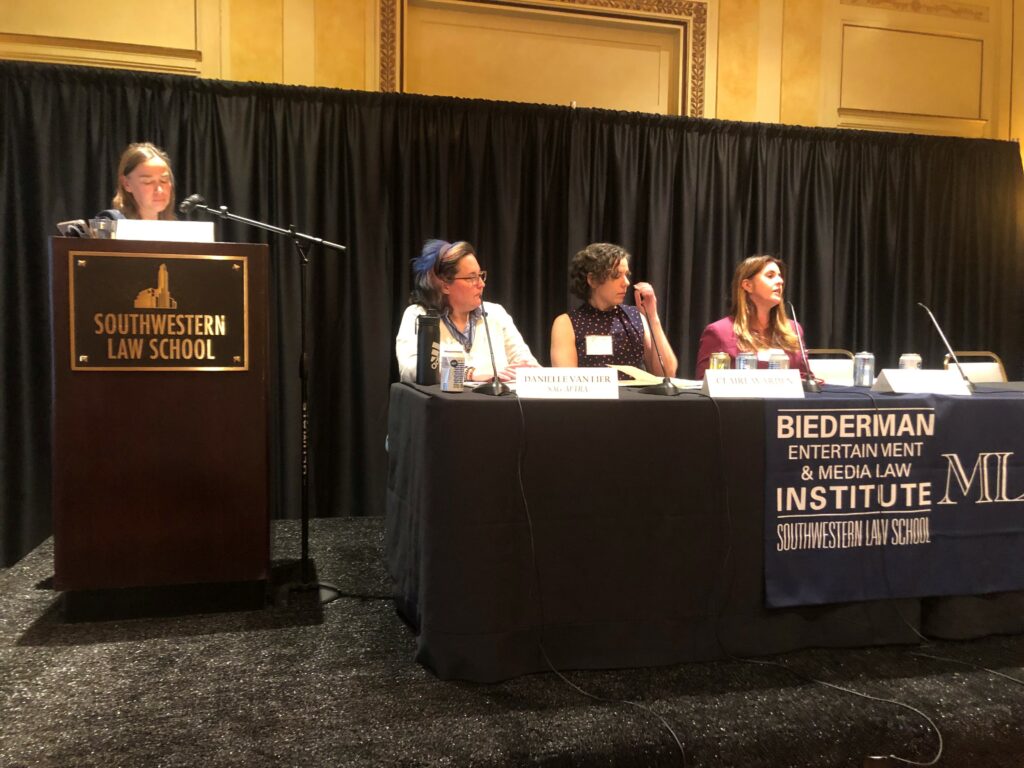
Finally, we ended the day with a Documentarian Roundtable, featuring the directors and producers of documentary films such as Darfur Now, ¡Viva Maestro!, The Holly, The Culture High, and Inmate #1: The Rise of Danny Trejo. The participants shared clips and discussed legal, political and safety issues they encountered during these productions, although unfortunately we ourselves encountered some technical issues that limited the participation one of our speakers. Diana Palacios (Davis Wright Tremaine) led the discussion, with filmmakers Ted Braun, Julian Rubinstein, Dean Schramm, and Adam Scorgie.
The conference received rave reviews, but I barely had time to enjoy the feedback before catching a plane the next morning to the MLRC’s next event in Miami.
Having started in 2013, this was our 11th conference addressing Legal Issues Concerning Hispanic and Latin American Media. Following eight meetings at the University of Miami, one event on Zoom during the pandemic, we’ve met the past two years at the lovely offices of Holland & Knight in downtown Miami overlooking Biscayne Bay.

We started the conference with a session on Protection for Journalists in Latin America moderated by Adolfo Jimenez, Holland & Knight, with two speakers participating via Zoom: Alexander Papachristou, Executive Director of the Cyrus R. Vance Center for International Justice; and Carlos Jornet, the executive editor of La Voz del Interior (a leading Argentinian newspaper) and also the press freedom coordinator for the Inter American Press Association. Alex described a soon-to-launch initiative called Reporter Shield, a global legal support program and defense fund for investigative journalists and newsrooms. The Reporter Shield program is designed to help protect and defend investigative journalists from defamation, libel, and other vexatious SLAPP type lawsuits. It will cover the costs of legal defense but not damage awards. And it will rely on developing a network of participating media defense lawyers – a function MLRC volunteered to assist with. Carlos Jornet, speaking in Spanish with simultaneous English translation via Zoom, went on to describe the pressures faced by journalists in Latin America, from lawsuits to government directed retaliation. He sketched out an environment made worse by the effect – even South of the border – of many years of Trump’s attacks on the press. The danger of being a journalist in Latin America is hardly hypothetical. Last year, 67 journalists were killed globally, 13 in Mexico alone; and since 1992 there were 151 killings of journalists in Mexico.
Next was a session on AI in Latin America, a blue-sky panel discussion about the legal, policy and business issues surrounding emerging AI technology. Moderated by Hilary Lane, Holland & Knight, the panel featured three lawyers from South America: Paula Mena Barreto, CMA Law, Brazil; Tatiana Carrillo, TCI PartnersLatAm, Colombia; and Maria Alejandra Santurio, Santurio, Andrada & Noel, Argentina. Among other things, they discussed nascent policy proposals to regulate AI technology, the copyright implications of “training” AI on copyrighted images and text; and how AI and journalism will interact.
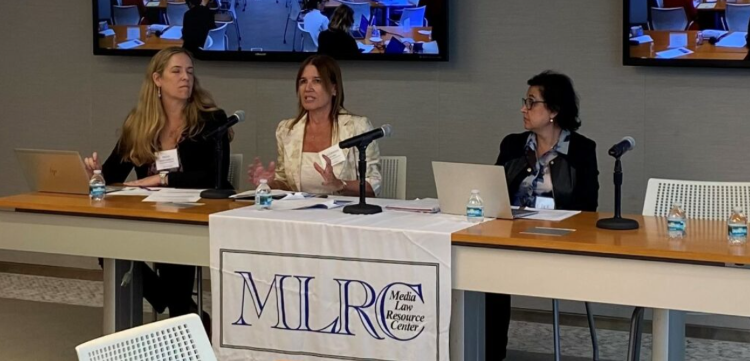
Following that was a ripped from the headline’s session called First Amendment Follies in Florida. Rachel Fugate, Shullman Fugate; Lynn Carrillo, NBCUniversal; and Dave Wilson, Senior Editor Local & State Government, Miami Herald, discussed Gov. DeSantis-inspired bills to reform Florida defamation law as well as Florida’s new “anti-woke” laws affecting students, faculty and libraries. While efforts to narrow public figure status and actual malice defenses run into obvious constitutional roadblocks, other proposals, such as narrowing the application of the Florida shield law in defamation cases and allowing plaintiffs to recover legal fees, could seriously impinge the press in Florida if enacted. Moreover, there is no transparency in these efforts to change Florida law since Governor DeSantis generally refuses to speak to much of the mainstream press in Florida. In addition, Dave Wilson noted that Florida’s “anti-woke” laws are creating havoc with a high school teacher recently fired for showing students a photograph of Michelangelo’s sculpture of David.
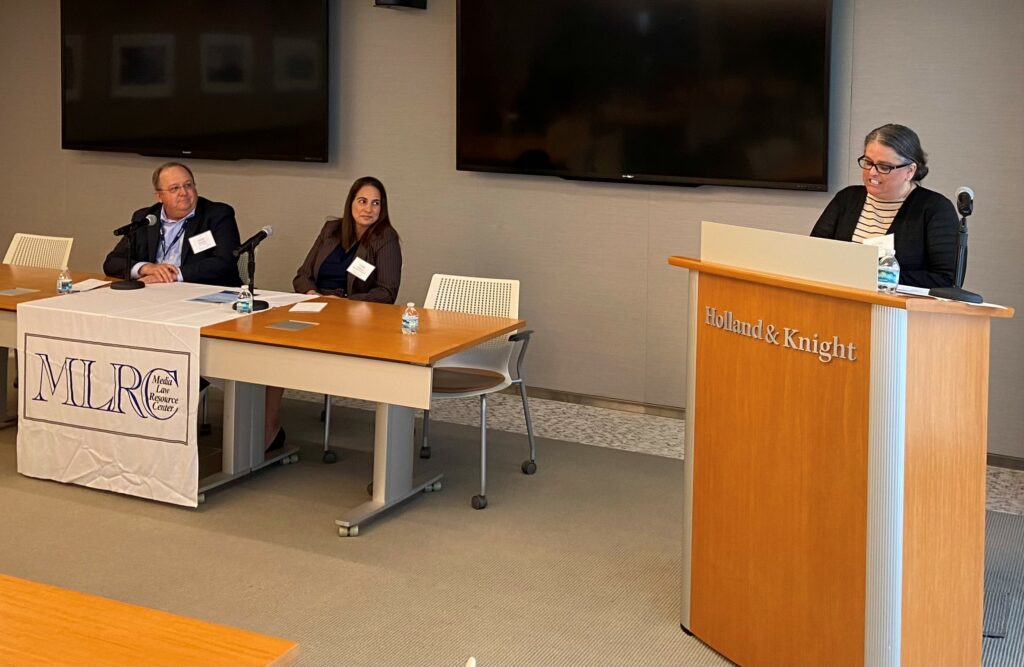
Following a bountiful lunch provided by host Holland & Knight, the conference continued with an hour-long Ethics Session focused on what media lawyers need to know about the Foreign Corrupt Practices Act. Marcelo Ovejero, Holland & Knight, provided a detailed overview of the statute and how it is implicated in cross-border media deals. He included the cautionary tale of how the FCPA was implicated in the British phone hacking scandal and fielded multiple questions on best practices and real world scenarios.
Next up was a Zoom book talk with Katherine Corcoran, author of In the Mouth of the Wolf: A Murder, a Cover-Up, and the True Cost of Silencing the Press. MLRC Deputy Director Dave Heller interviewed the former Mexico bureau chief of AP and discussed her book which investigates the 2012 murder of journalist Regina Martínez. While the government portrayed the murder as a crime of passion, and obtained a conviction of a neighbor of Martinez’s, Corcoran’s book convincingly argues this was a coverup and that Martinez was murdered because she was on the verge of exposing serious government corruption in Mexico.
The final conference session tackled Comparative Legal and Business Issues Surrounding Biopics and Docudramas. Moderator Diana Palacios, Davis Wright Tremaine; and panelists James Sammataro, Pyror Cashman; Rita Chertorivski, TelevisaUnivision; and Roxana Kahale, Kahale Abogados, Argentina, began with a discussion of “life rights” – what are they, whether they are necessary, and comparative practices in the US and Latin America. Noted by all was the risk of complaints from tertiary characters in docudramas who were not included in a life rights agreement leading to thorny libel and privacy issues.
As is plain from this description, this is an extremely diverse conference, including speakers and attendees from the major South American countries. In that sense, and given its unique focus on Latin American media issues, it is a pretty unique gathering on U.S. soil. Likewise, the Los Angeles conference is pretty special, offering a deeper dive into Entertainment Law (with a dollop of First Amendment issues thrown in) than in most other meetings. The back-to-back scheduling of both conferences this year was rather coincidental. We haven’t yet decided whether we’ll duplicate the Sunshine Double next year.
George Freeman is Executive Director of the MLRC.